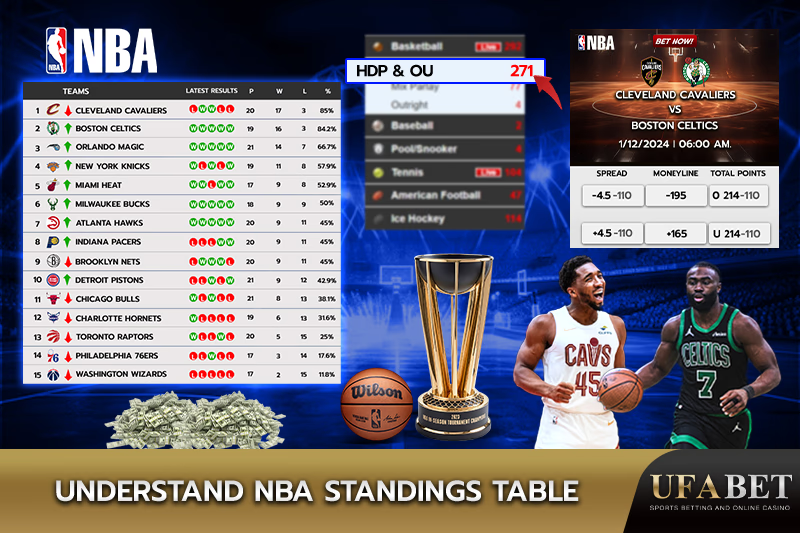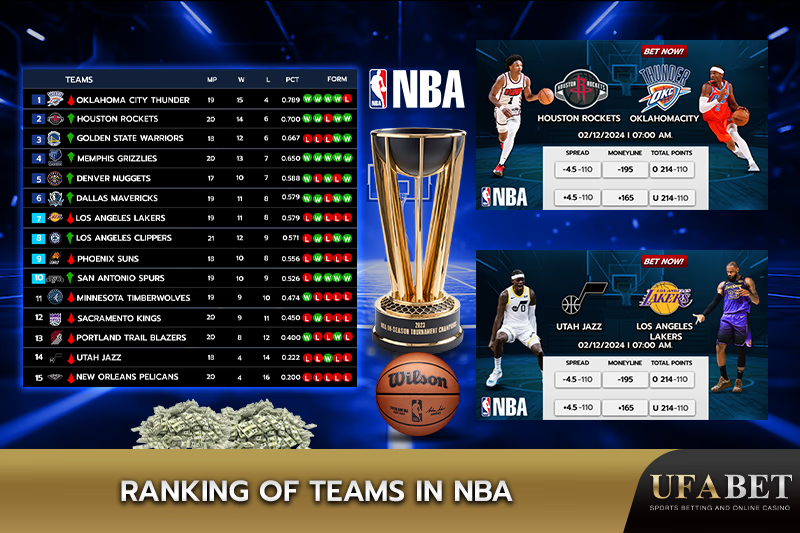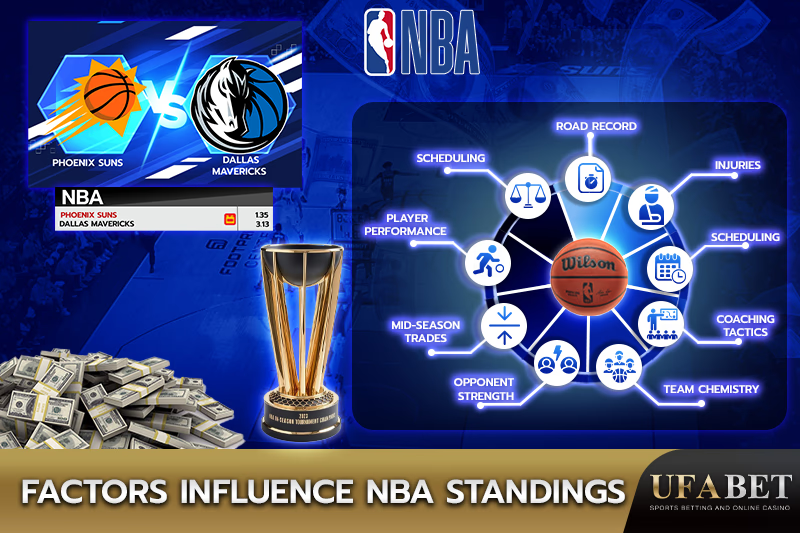NBA Standings 2025/2026 : NBA Leaderboard, Rankings, and Table
The National Basketball Association (NBA) is a premier professional basketball league based in the United States, widely regarded as the pinnacle of basketball excellence worldwide. The league has become a global phenomenon celebrated for its elite athletes, thrilling games, and cultural impact. It was established in 1946 as the Basketball Association of America (BAA) before merging with the National Basketball League (NBL) in 1949 to form the NBA. Thirty NBA teams were divided into two conferences, the Eastern and Western. The NBA features an 82-game regular season followed by a highly competitive postseason. Players in the league are known for their remarkable athleticism, skill, and influence, with many becoming global icons, such as Michael Jordan, LeBron James, and Stephen Curry. The NBA fosters international engagement through broadcasts in over 200 countries and initiatives like the NBA Global Games beyond its on-court action. The league is celebrated for embracing innovation, from its advanced analytics and player-tracking technology to its active presence on social media platforms. The NBA emphasizes social justice, diversity, and charitable efforts through programs like NBA Cares off the court. The NBA continues to shape the basketball world and influence popular culture with its blend of competitive sportsmanship, entertainment, and global appeal.
The major purpose of the NBA Standing Table is to determine which teams advance to the postseason while outlining the qualifications for the play-in tournament. The NBA Table standing is to provide a clear and structured representation of team rankings throughout the season based on their performance metrics. The NBA standings track critical data such as wins, losses, winning percentage, games back from the leading team, and divisional and conference records. It helps determine playoff seeding, ensuring that the top-performing teams advance to the postseason while outlining qualifications for the play-in tournament. The NBA standings table offers fans, analysts, and teams an easy way to monitor progress, evaluate team dynamics, and compare performance against competitors. It is a critical tool for making strategic decisions, including game planning, player management, and trade considerations, while maintaining an organized framework for the league’s competitive structure.
The NBA consists of 30 teams, divided equally between the Eastern and Western Conferences, each containing 15 teams. The Eastern Conference Standings include three divisions, the Atlantic, Central, and Southeast, featuring teams like the Boston Celtics, Milwaukee Bucks, and Miami Heat. The Western Conference Standings are similarly structured, with the Northwest, Pacific, and Southwest divisions, including teams such as the Golden State Warriors, Los Angeles Lakers, and Denver Nuggets. These divisions and conferences are essential for organizing the regular season schedule and determining playoff qualifications. The structure ensures competitive balance and regional representation while fostering rivalries and local fan engagement. The split is critical in playoff seeding, as teams compete for top positions and postseason berths within their conferences.
Betting on the NBA games with UFABET offers a comprehensive and user-friendly platform tailored for basketball enthusiasts. UFABET provides diverse betting options, including moneylines, point spreads, over/under totals, and live in-game wagers, ensuring flexibility for all bettors. The platform features competitive NBA odds, real-time updates, and detailed statistics, enhancing the betting experience and enabling informed decision-making. UFABET allows users to place bets confidently, is supported by quick deposits and withdrawals, and has a secure and seamless interface. It includes promotional bonuses and rewards, increasing value for users. UFABET delivers a dynamic and engaging experience for NBA fans, whether following favorites like the Los Angeles Lakers or betting on underdog teams.
NBA Standings 2025/2026 Season


Coming soon
How to Understand the NBA Standings Table?

How Important is the NBA Rankings for Betting?


NBA rankings for betting is important because it is a foundational tool for understanding team performance, dynamics, and potential outcomes. The NBA standings provide critical insight into how teams fare in terms of wins, losses, and performance, which is instrumental in assessing NBA odds and making informed betting decisions. For instance, higher-seeded teams in the standings indicate consistent performance, suggesting stronger form and momentum. However, digging deeper into the attributes of the standings, such as home and away records, recent win streaks, and point differentials, offers bettors a more nuanced understanding of each team's strengths and vulnerabilities. Teams with strong home records thrive under the influence of home-court advantage, making them favorable bets when playing at home, while teams with poor away records struggle on the road, highlighting potential betting opportunities against them.
Analyzing advanced statistics like offensive and defensive ratings, which measure points scored or allowed per 100 possessions, helps bettors predict game flow and total points, which is critical for betting on point spreads and totals. Teams with high offensive ratings are typically more reliable in covering spreads or surpassing game totals, while teams with elite defensive ratings are likelier to keep games under the set total. NBA standings reveal conference and division records, which are pivotal when betting on games involving divisional or conference rivals. Teams with dominant division records have shown an ability to exploit specific matchups, making them strong candidates for bets against division opponents.
Other factors tied to the NBA standings that directly affect NBA odds include rest days and injury reports. Teams playing multiple games within a short time frame often face fatigue, reducing their efficiency and increasing their chances of losing or failing to cover spreads. Teams with ample rest days are better prepared and more likely to perform well. Keeping tabs on injury reports for key players is equally vital. The absence of a star player significantly impacts a team's chances, tilting the odds and providing an advantage to bettors who adjust their wagers accordingly.
Matchup history is another attribute that plays a significant role in betting. The standings reflect historical patterns, such as a team consistently dominating or struggling against specific opponents. Bettors use these trends to anticipate likely outcomes. For example, bettors leverage such knowledge when placing bets if a defensively robust team repeatedly neutralizes a high-scoring opponent.
NBA standings are a critical resource for analyzing NBA odds and betting strategies. Attributes like home and away records, rest days, offensive and defensive ratings, and matchup history provide actionable insights that improve the accuracy of predictions. Incorporating these data points into betting decisions allows bettors to identify value opportunities and minimize risks, making rankings a cornerstone of successful sports betting strategies. Bettors gain a competitive edge while enjoying the thrilling dynamics of NBA Betting by staying informed and attentive to these details.
How are Teams Ranked for Positions in the NBA Standings?
Teams are ranked for positions in the NBA standings based on a combination of factors, primarily their win-loss records throughout the regular season. The standings are divided into two conferences, Eastern and Western, with each team competing for the highest possible seed to secure playoff berths or favorable matchups. A team’s winning percentage, calculated as wins divided by total games played, is the foundational criterion for ranking. Beyond simple records, the NBA employs a series of tiebreakers when two or more teams share identical records. Head-to-head performance between tied NBA teams is the first factor, giving an edge to the team with the better record in their direct matchups. The team with the superior division record is ranked higher if the tie persists and the teams are in the same division. Conference records come into play for ties involving teams within the same conference, reflecting performance against shared opponents.
Other metrics include records against teams eligible for the playoffs within the same and opposing conferences, emphasizing performance in higher-stakes matchups. Point differential is the final tiebreaker, which measures the net points a team scores versus what they allow across the season. A higher point differential reflects a team’s ability to dominate games, adding weight to its ranking when other criteria are equal.
The NBA rankings system ensures fairness and rewards consistent, high-level performance while maintaining competitive balance. These standings influence playoff seeding, play-in tournament eligibility, and home-court advantage. The top six seeds in each conference earning direct playoff spots, seeds 7-10 competing in the play-in tournament, and the top seeds gaining the benefit of facing lower-ranked opponents. The structured ranking system creates stakes for every game, as even slight shifts in standings affect postseason outcomes.
What are the Factors that Influence the NBA Standings?
The Factors that Influence the NBA Standings are listed below.
- Player Performance: Player performance is the cornerstone of a team’s success and position in the NBA standings. High-scoring players, versatile defenders, and efficient shooters elevate a team’s effectiveness. Key metrics like points per game, rebounds, assists, and shooting percentages reflect individual contributions. Teams with consistent star performers or deep rosters capable of stepping up in critical moments often find themselves in higher standings.
- Injuries: Injuries to crucial players significantly alter a team’s trajectory. The absence of a star player disrupts team strategies, weakening defenses and reducing offensive efficiency. Teams that effectively manage injuries through depth in their roster or by adjusting game plans maintain better standings. However, chronic or mid-season injuries derail even the most competitive teams, leading to losing streaks and lower NBA rankings.
- Coaching strategies and tactical decisions: Coaches influence the standings through strategy, rotations, and in-game adjustments. Effective coaching ensures players are positioned to maximize their strengths and counter opponents' strategies. Teams with visionary coaches who excel in game preparation, player development, and managing high-pressure situations often outperform their peers in the standings.
- Scheduling: The NBA schedule, with its demanding 82-game season, impacts team performance and standings. Back-to-back games, travel fatigue, and long road trips hinder team performance. Teams with favorable schedules that minimize travel or cluster home games together are likely to perform better. Grueling schedules with multiple road games against top-tier opponents lead to fatigue and lower standings.
- Team Chemistry: Strong team chemistry translates into cohesive on-court performance. Teams with well-synchronized offensive and defensive schemes, where players trust and understand each other’s roles, tend to outperform less cohesive units. Poor chemistry, caused by egos, miscommunications, or internal conflicts, leads to inconsistent performances and a drop in the standings.
- Strength of Opponents: The teams a franchise faces during the season significantly impact standings. Playing against teams with winning records or elite players poses challenges, whereas games against weaker opponents are opportunities to improve standings. The difficulty of a team's schedule, often referred to as "strength of schedule," is a critical determinant of its final ranking.
- Mid-season Trades and Acquisitions: Trades and acquisitions during the season influence a team’s performance and standings. A strategic trade that brings in a high-impact player strengthens a team's weaknesses and propels it higher in the standings. However, poorly executed trades or the loss of a key player disrupt team chemistry and lead to a decline in performance.
- Road Record: Success on the road strongly indicates a team’s resilience and competitiveness. Teams with solid road records demonstrate their ability to perform under challenging conditions, such as hostile crowds and unfamiliar arenas. Poor road performance is a major factor in lower standings, even for teams with strong home records.
- Off-court Issues: Off-court distractions, such as contract disputes, legal issues, or organizational conflicts, affect a team's focus and morale. These issues translate into inconsistent performances and poor standings on the NBA leaderboard. Teams that keep off-court matters in check and maintain a professional environment are better positioned to succeed in the standings.
What is the Format for NBA Games?


The format for NBA games during the playoffs is structured to determine the league's champion clearly and competitively. The postseason begins with 16 teams, eight from each conference, earning spots based on their regular season performance. The top six teams in each conference qualify directly for the playoffs, while the seventh to tenth seeds participate in a play-in tournament to secure the final two playoff spots. The playoffs are divided into four rounds: the first round, conference semifinals, conference finals, and the NBA Finals.
Each round follows a best-of-seven series format, where the first team to win four games advances to the next stage. The structure ensures fairness by giving teams multiple opportunities to prove their superiority. Matches are held in a 2-2-1-1-1 sequence for home-court advantage, meaning the team with the higher seeding hosts games 1, 2, 5, and 7 if needed, while the lower-seeded team hosts games 3, 4, and 6. The bracket remains fixed, so teams do not get reseeded after each round, emphasizing the importance of each matchup. The structured yet dynamic format balances competitive rigor with entertainment, making each series a battle of strategy, endurance, and skill.
The Format for NBA Games are listed below.
- Regular Season: The NBA Regular Season is the primary phase of the league's competition, where all 30 teams play a set schedule of 82 games each to determine their rankings and eligibility for the playoffs. The phase runs from October to April, with teams competing against opponents within and from the opposite conference. The Regular Season serves multiple purposes, it establishes team standings, showcases individual and team performances, and provides fans with a consistent slate of games over several months. Teams accumulate wins and losses during such a phase, and their performance is reflected in the NBA standings, divided into the Eastern and Western Conferences. Key metrics rank teams, such as win percentage, conference records, and division standings. The top six teams from each conference automatically qualify for the playoffs, while teams ranked seventh to tenth compete in the play-in tournament for the remaining playoff spots. The Regular Season enables players to vie for individual accolades, such as MVP, and teams to refine strategies before the intense postseason. It contributes to the league's entertainment value, with exciting matchups, rivalries, and fan engagement across the globe.
- In-Season Tournament: The NBA In-Season Tournament is a newly introduced competitive event designed to add excitement and stakes to the regular season while offering teams a chance to compete for additional honors beyond the NBA Championship. Implemented to enhance fan engagement and player motivation, the tournament occurs during the early portion of the regular season in November. The tournament involves all 30 NBA teams, split into groups based on their previous season's performance. Teams compete in group-stage games integrated into the regular season schedule, with results counting toward the tournament and the regular standings. The top-performing teams from each group and select wild-card teams advance to a single-elimination knockout phase. The event's culmination is the championship game, played at a neutral site. The In-Season Tournament includes incentives such as financial bonuses for players and staff and a unique championship trophy, adding layers of competition and achievement. It offers intensified matchups and a playoff-like atmosphere earlier in the season for fans, breaking up the regular season's long schedule with a focused, high-stakes event. It encourages teams to compete at a high level earlier in the season, creating memorable moments and showcasing the league's talent on a broader stage.
- Group Stage: The Group Stage in the NBA, part of the recently introduced In-Season Tournament, is a competitive phase where all 30 teams participate, divided into smaller groups within their respective conferences. These groups are formed based on a random draw, factoring in the teams' performances from the previous regular season. The Group Stage games are played as part of the regular-season schedule, giving the matches dual significance, contributing to both the In-Season Tournament and regular-season standings. Each team competes against the other teams in its group in a round-robin format, with the outcomes determining which teams advance to the next phase, such as the knockout rounds. These games create an added layer of excitement and stakes for teams and fans early in the season. The Group Stage encourages strategic play and gives less dominant teams a chance to make an impact, as success here leads to qualification for later stages of the tournament, where substantial prizes and prestige are at stake.
- Knockout Stage: The Knockout Stage in the NBA refers to the elimination rounds of the In-Season Tournament, where teams compete in a high-stakes format to determine the champion. The top teams from each group and a few wild-card teams based on performance advance to the phase after the Group Stage. The Knockout Stage consists of single-elimination games, meaning teams must win to move forward, and a loss results in immediate elimination from the tournament. The stage begins with the quarterfinals, followed by the semifinals, culminating in the championship game. The games are designed to intensify competition as teams face off directly, with no margin for error. Every game in the Knockout Stage has a definitive winner, unlike regular-season matchups, adding playoff-like intensity to the tournament. The finals, held at a neutral venue, crown the tournament champion, with the victors earning a cash prize and additional prestige. The Knockout Stage amplifies excitement for fans and players alike, as it brings a sense of urgency and drama to the middle of the NBA season, breaking the routine of regular play and providing opportunities for standout performances.
- Play-in Tournament: The Play-In Tournament in the NBA is a postseason event introduced to determine the final two playoff seeds in each conference (Eastern and Western). It occurs after the regular season and before the playoffs, featuring teams that finished in the 7th to 10th positions in the NBA standings for each conference. The format ensures competitive play among teams that narrowly missed securing a direct playoff spot, offering them an additional chance to qualify. The tournament begins with the 7th and 8th seeds playing a single game, where the winner secures the 7th seed in the playoffs. The 9th and 10th seeds compete in an elimination game, with the loser being eliminated. The winner of the 9th vs. 10th game then faces the loser of the 7th vs. 8th game in a final matchup, with the victor earning the 8th and final playoff spot. The tournament adds excitement and stakes for teams on the playoff bubble, incentivizing stronger performances during the regular season and providing fans with high-stakes basketball leading into the playoffs. It has become a permanent part of the NBA postseason format since the 2021 season.
- Championship Game (Finals): The NBA Finals, the league's championship game, is the season's climax. It features the Eastern Conference champion competing against the Western Conference champion to determine the league's ultimate winner. The series is a best-of-seven format, meaning the first team to win four games secures the coveted Larry O’Brien Trophy. The Finals are the pinnacle of NBA competition, showcasing the season's best teams and players under the brightest lights. Games alternate between the two competing teams' arenas in a 2–2–1–1–1 format, with the team holding the better regular-season record enjoying home-court advantage. The stage of the postseason highlights intense rivalries, legendary performances, and strategic gameplay as teams leave everything on the court in pursuit of basketball's ultimate prize. Individual accolades like the NBA Finals MVP award are given to the most outstanding player of the series and the championship title. The Finals are a global spectacle, drawing millions of viewers worldwide and representing the culmination of months of hard-fought games. It is the definitive moment of glory and achievement for fans, players, and teams in professional basketball.
- Playoffs: The NBA Playoffs are postseason elimination tournaments that determine the league's champion. Following the regular season, the top six teams from each conference qualify directly, while the 7th to 10th seeded teams compete in a Play-In Tournament to secure the final two playoff spots in each conference. The playoffs consist of four rounds, the First Round, Conference Semifinals, Conference Finals, and the NBA Finals. Each round is a best-of-seven series, where the first team to win four games advances to the next stage. Teams are ranked based on their performance in the regular season, with higher-seeded teams enjoying home-court advantage. The playoffs highlight the league's best talent and feature intense competition and dramatic moments that captivate basketball fans worldwide.
- Rounds: Rounds in the NBA refer to the stages of competition in the playoffs, where teams compete in a series of games to advance toward the championship. The playoffs are divided into four main rounds. The First Round involves eight teams from each conference (Eastern and Western) competing in a best-of-seven series, with matchups determined by seeding, such as the 1st seed facing the 8th seed, 2nd vs. 7th, and so on. The winners progress to the Conference Semifinals, where the remaining four teams in each conference face off in another set of best-of-seven series. The Conference Finals follow, featuring the two best teams from each conference competing to determine the Eastern and Western Conference champions, who then advance to the final stage. The NBA Finals serve as the championship round, where the Eastern and Western Conference champions face each other in a best-of-seven series to claim the NBA title. Each round is structured to progressively eliminate teams until a single champion emerges, ensuring a competitive and dramatic journey toward the ultimate prize.


















